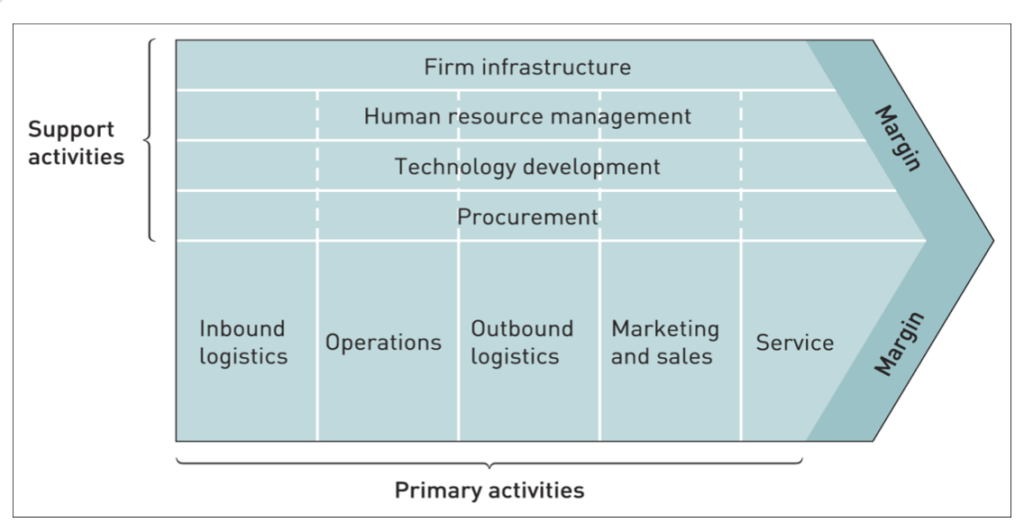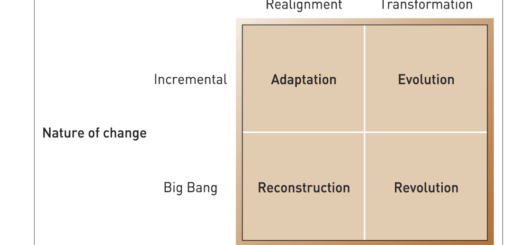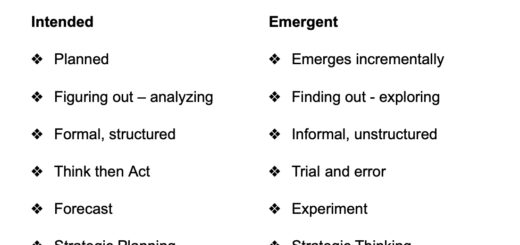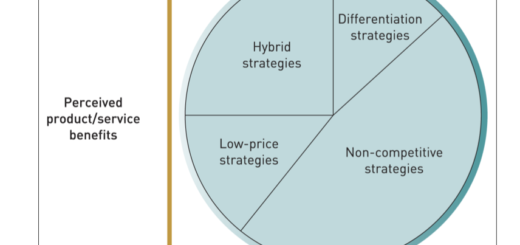Value Chain Analysis
Value chain analysis was first introduced by Michael Porter in his book “Competitive Advantage: Creating and Sustaining Superior Performance” in 1985. Porter is a renowned scholar and strategist who has made significant contributions to the field of business strategy and competitive advantage.
Value chain analysis has become an important tool for businesses to evaluate their internal activities, identify areas for improvement, and create value for their customers. As a result, value chain analysis has become a widely accepted and widely used framework for businesses and scholars alike.
Value chain analysis typically involves breaking down a business’s activities into primary and support activities.

Primary Activities:
Primary activities are those that are directly involved in the creation or delivery of a product or service, and include inbound logistics, operations, outbound logistics, marketing and sales, and service.
- Inbound logistics: This includes all activities related to receiving, storing, and distributing inputs or materials to the production process. Examples include raw materials handling, inventory management, and supplier management.
- Operations: This includes all activities involved in transforming inputs into finished products or services. Examples include manufacturing, assembly, and packaging.
- Outbound logistics: This includes all activities involved in distributing the finished product to customers. Examples include transportation, warehousing, and order processing.
- Marketing and sales: This includes all activities involved in promoting the product and selling it to customers. Examples include advertising, market research, and sales force management.
- Service: This includes all activities involved in providing after-sales service and support to customers. Examples include warranty management, repairs, and customer service.
Supportive Activities:
Support activities are those that enable primary activities to take place, and include procurement, technology development, human resource management, and firm infrastructure.
The supportive activities in a value chain analysis are the activities that are not directly involved in creating or delivering the product or service, but that support the primary activities and help them function more efficiently. These supportive activities are:
- Procurement: This includes all activities related to acquiring the inputs or materials needed for the production process. Examples include supplier selection, negotiation, and purchasing.
- Technology development: This includes all activities related to the research, development, and improvement of technology to support the production process. Examples include research and development, process automation, and technology acquisition.
- Human resource management: This includes all activities related to managing the organization’s workforce. Examples include recruitment, training, performance management, and compensation.
- Firm infrastructure: This includes all activities that support the entire organization, such as finance, accounting, legal, and management information systems.
By analyzing each activity in the value chain, a business can identify areas where it can add value, reduce costs, or improve efficiency. For example, a business might use value chain analysis to identify opportunities to reduce procurement costs by negotiating better prices with suppliers or to improve product quality by investing in new technology for production.
Overall, value chain analysis is a powerful tool for businesses to gain a better understanding of their operations and to identify opportunities for strategic improvements that can lead to greater competitiveness and profitability.
Example: Smart Phone Company
Let’s take the example of a company that produces and sells smartphones. Here’s an example of how value chain analysis could be applied:
Primary activities:
- Inbound logistics: The company procures components and raw materials, such as processors, screens, batteries, and casing, from its suppliers. The company may negotiate contracts with suppliers to get better prices and delivery times.
- Operations: The company assembles the components and assembles them into finished smartphones. The company may use advanced manufacturing processes to ensure efficiency and quality.
- Outbound logistics: The company ships the finished smartphones to its retail partners or directly to customers. The company may use a logistics company to handle shipping and distribution.
- Marketing and sales: The company advertises and promotes its smartphones to potential customers through various channels, such as social media, television, and print. The company may use customer data to target specific demographics and personalize marketing messages.
- Service: The company provides customer service and support, such as warranty repairs, technical assistance, and troubleshooting.
Supportive activities:
- Procurement: The company sources components and raw materials from various suppliers, negotiating favorable contracts and ensuring timely delivery.
- Technology development: The company invests in research and development to create innovative features and improve the performance of its smartphones.
- Human resource management: The company hires and trains employees to ensure a skilled and motivated workforce. The company may offer employee benefits, such as health insurance and retirement plans, to attract and retain talent.
- Firm infrastructure: The company maintains an organizational structure that supports its business goals. This includes finance, accounting, legal, and management information systems.
By analyzing the value chain activities, the company could identify opportunities to improve its efficiency and reduce costs. For example, the company may identify opportunities to improve its procurement process by negotiating better contracts with suppliers or by consolidating its supply chain. Alternatively, the company may invest in research and development to create new features that differentiate its smartphones from its competitors. By improving its value chain activities, the company can create a competitive advantage and improve its overall profitability.
Example of a Coffee Shop
Let’s take the example of a coffee shop to illustrate the concept of value chain analysis:
- Inbound logistics: The coffee shop needs to purchase coffee beans, milk, sugar, and other ingredients from suppliers. The shop also needs to manage inventory levels and ensure that the supplies are fresh and of high quality.
- Operations: The coffee shop needs to roast the coffee beans, brew the coffee, steam the milk, and prepare the food items. The shop also needs to ensure that the environment is clean and welcoming for customers.
- Outbound logistics: The coffee shop needs to serve the coffee and food items to customers in a timely and efficient manner. The shop also needs to ensure that the orders are accurate and that the products are presented attractively.
- Marketing and sales: The coffee shop needs to attract customers through advertising, promotions, and word of mouth. The shop also needs to ensure that the staff is knowledgeable and friendly and that the shop provides a good customer experience.
- Service: The coffee shop needs to provide excellent customer service, including addressing any complaints or issues that arise.
Supportive activities:
- Procurement: The coffee shop needs to purchase ingredients and supplies from reliable suppliers at a reasonable cost. The shop may also need to negotiate contracts and manage relationships with suppliers.
- Technology development: The coffee shop may need to invest in technology to improve its processes, such as a point-of-sale system or a mobile app for ordering and payment.
- Human resource management: The coffee shop needs to hire and train staff, manage employee schedules, and ensure that the staff is motivated and engaged.
- Firm infrastructure: The coffee shop needs to manage its finances, including accounting and tax compliance. The shop also needs to manage its physical space and equipment.
By analyzing each of these activities and identifying ways to improve efficiency and effectiveness, the coffee shop can reduce costs, improve quality, and create value for its customers. For example, the shop may identify a more efficient way to manage inventory or negotiate better prices with suppliers to reduce costs. The shop may also invest in staff training and technology to improve the customer experience and differentiate itself from competitors.




